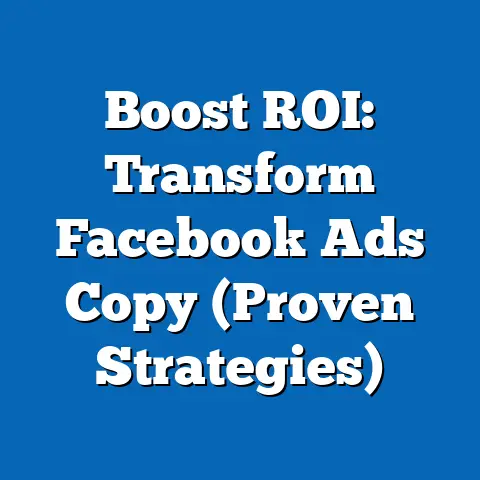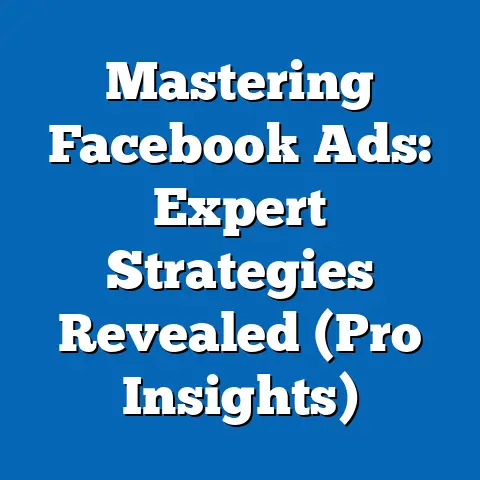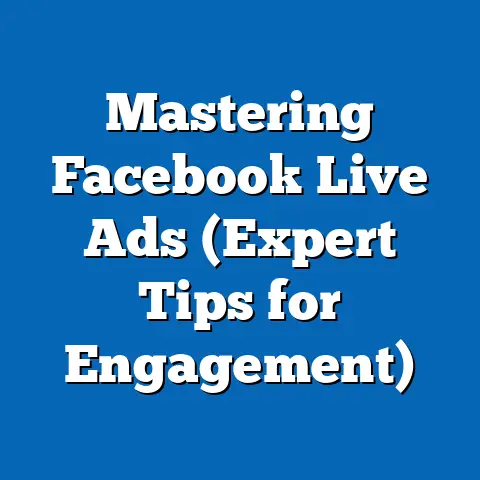Unpacking the Democrats’ Facebook Ads Strategy (Insightful Analysis)
In an era where social media platforms like Facebook are heralded as tools for democratic engagement, the very same platforms have become battlegrounds for political influence, creating a dichotomy of connection and isolation. It’s a paradox I’ve witnessed firsthand, both as a digital marketing strategist and as a citizen observing the ever-evolving landscape of political communication. The Democratic Party, like any political entity, has had to adapt to this new reality, crafting a sophisticated Facebook advertising strategy that aims to connect with voters, persuade the undecided, and ultimately, win elections. Let’s dive into the mechanics, successes, challenges, and future of this strategy.
Historical Context of Political Advertising on Facebook
The evolution of political advertising on Facebook is a fascinating, and sometimes unsettling, story. Before 2016, political ads were a relatively minor part of the platform’s revenue stream. Campaigns primarily focused on traditional media and grassroots organizing. However, the 2016 election changed everything. The use of Facebook by foreign actors to spread misinformation and sow discord highlighted the platform’s vulnerability and its potential for misuse.
I remember the shock and disbelief that followed the election. As marketers, we understood the power of targeted advertising, but the scale and impact of its manipulation were eye-opening. It forced a reckoning, not just for Facebook, but for all of us involved in digital communication.
The Democrats, in particular, had to reassess their approach. They realized that relying solely on traditional methods wouldn’t cut it in the new digital age. They needed to understand the nuances of Facebook’s algorithm, the power of targeted messaging, and the importance of combating misinformation. The 2020 election saw a much more sophisticated and data-driven approach from the Democrats, reflecting lessons learned from the past. According to Statista, political ad spending on Facebook in the 2020 election cycle reached over $1.5 billion, a testament to the platform’s growing importance in political campaigns.
Key Takeaway: The 2016 election was a turning point, forcing Democrats to embrace a more sophisticated and data-driven approach to Facebook advertising.
The Mechanics of the Democrats’ Facebook Ads Strategy
The Democrats’ Facebook Ads strategy is a complex machine, finely tuned to reach specific demographics and deliver persuasive messages. At its core, it relies on a data-driven approach to targeting. This means using Facebook’s extensive data on users – age, location, interests, behaviors, even their purchase history – to identify and reach potential voters.
Data-Driven Targeting:
One of the most powerful aspects of Facebook advertising is its granular targeting capabilities. I’ve seen campaigns target audiences based on incredibly specific criteria, like “parents of children aged 5-7 who are interested in environmental issues and live in swing states.” The Democrats leverage this power to create highly targeted ads that resonate with specific segments of the population.
For example, they might target young, urban voters with messages about climate change and social justice, while reaching out to older, suburban voters with ads focused on healthcare and economic security. This level of personalization is crucial for cutting through the noise and delivering messages that truly connect with voters.
A/B Testing and Optimization:
The Democrats don’t just throw ads out there and hope for the best. They use A/B testing to continuously refine their messaging and creative assets. This involves creating multiple versions of an ad with slight variations – different headlines, images, or calls to action – and then showing them to different segments of the audience. By tracking which versions perform best, they can optimize their campaigns for maximum impact.
I once worked on a campaign where we A/B tested five different headlines for a single ad. The winning headline generated a 30% higher click-through rate than the worst-performing one. This small change had a significant impact on the overall campaign performance, highlighting the importance of continuous testing and optimization.
Pixel Tracking and Retargeting:
Pixel tracking is another key component of the Democrats’ Facebook Ads strategy. The Facebook Pixel is a small piece of code that can be placed on a website to track user behavior. This allows campaigns to retarget users who have previously interacted with their website or ads.
For example, if someone visits a campaign website to learn more about a candidate’s platform, they can be retargeted with ads that encourage them to donate or volunteer. Retargeting is a powerful tool for nurturing leads and driving conversions, as it allows campaigns to stay top-of-mind with potential voters.
Visual Content and Messaging Tone:
The Democrats are also acutely aware of the importance of visual content and messaging tone. They use high-quality images and videos that are visually appealing and emotionally engaging. Their messaging is carefully crafted to resonate with their target audience, often focusing on values like fairness, equality, and opportunity.
During the 2020 election, I noticed a significant shift in the Democrats’ messaging. They moved away from overly negative attacks on their opponents and focused more on highlighting their own positive vision for the future. This shift was likely driven by data showing that voters were turned off by negativity and preferred to hear about solutions and hope.
Key Takeaway: The Democrats’ Facebook Ads strategy is a data-driven, highly targeted, and constantly optimized machine designed to reach specific voters with persuasive messages.
Case Studies of Successful Campaigns
To illustrate the effectiveness of the Democrats’ Facebook Ads strategy, let’s examine a couple of specific case studies.
Case Study 1: The 2018 Midterm Elections – “Blue Wave” Campaign:
The Democrats’ success in the 2018 midterm elections was partly attributed to their effective use of Facebook advertising. Their “Blue Wave” campaign focused on energizing Democratic voters and persuading undecided voters to support their candidates.
- Objective: Increase voter turnout and win back control of the House of Representatives.
- Creative Assets: The campaign used a mix of video ads, image ads, and carousel ads. Video ads featured candidates speaking directly to voters about their values and policy priorities. Image ads highlighted key issues, such as healthcare and education. Carousel ads showcased a range of Democratic candidates and their platforms.
- Targeting: The campaign targeted a wide range of demographics, including young voters, women, and minority groups. They also focused on swing states and districts where the election was expected to be close.
- Outcomes: The “Blue Wave” campaign was highly successful, helping the Democrats win back control of the House of Representatives. The campaign generated high click-through rates and engagement levels, and it played a significant role in driving voter turnout.
Case Study 2: The 2020 Presidential Election – Biden-Harris Campaign:
The Biden-Harris campaign used Facebook advertising to effectively communicate their message and reach voters during the 2020 presidential election.
- Objective: Defeat Donald Trump and win the presidency.
- Creative Assets: The campaign used a mix of video ads, image ads, and text-based ads. Video ads featured Joe Biden and Kamala Harris speaking about their vision for the country. Image ads highlighted key policy proposals, such as the Build Back Better plan. Text-based ads focused on combating misinformation and encouraging voters to register and vote.
- Targeting: The campaign targeted a broad range of demographics, including swing states, suburban voters, and undecided voters. They also focused on reaching out to minority groups and young voters.
- Outcomes: The Biden-Harris campaign was highly successful, helping them win the presidency. The campaign generated high click-through rates and engagement levels, and it played a crucial role in mobilizing voters and combating misinformation.
I distinctly recall the feeling of optimism surrounding the Biden-Harris campaign. Their messaging was clear, consistent, and focused on unity and hope. Their Facebook ads reflected this, and it resonated with voters.
Key Takeaway: Successful Democratic Facebook ad campaigns focus on clear messaging, targeted outreach, and engaging creative assets.
Challenges and Controversies
Navigating Facebook’s advertising landscape is not without its challenges and controversies. The spread of misinformation, the platform’s evolving policies, and the intense competition from opposing parties all pose significant hurdles.
Misinformation and Fake News:
One of the biggest challenges facing the Democrats, and any political advertiser, is combating misinformation and fake news. Facebook has struggled to effectively police its platform, and false or misleading information can spread rapidly, particularly among certain demographic groups.
I’ve seen firsthand how difficult it can be to debunk false claims and counter misinformation. It requires constant vigilance, rapid response, and a willingness to engage with critics and fact-checkers. The Democrats have invested heavily in fact-checking and content moderation to combat misinformation, but it remains a constant battle.
Platform Policies and Restrictions:
Facebook’s advertising policies are constantly evolving, and they can be difficult to navigate. The platform has introduced restrictions on political advertising, such as banning ads that contain false or misleading information, but these policies are not always consistently enforced.
I remember a campaign where we had an ad rejected by Facebook for violating its policies, even though we believed it was factually accurate and compliant. It took several appeals and a lot of back-and-forth with Facebook’s support team to get the ad approved. This experience highlighted the challenges of working within Facebook’s often opaque and inconsistent policy framework.
Ethical Implications of Targeted Advertising:
The ethical implications of targeted advertising are another source of controversy. Critics argue that targeting voters with personalized messages based on their demographic data can be manipulative and divisive. They also raise concerns about the potential for microtargeting to exacerbate existing social inequalities.
I believe that targeted advertising can be a powerful tool for good, but it must be used responsibly and ethically. Campaigns should be transparent about their targeting practices and avoid using manipulative or deceptive tactics. They should also be mindful of the potential for microtargeting to exacerbate social inequalities and strive to reach out to a broad range of voters with inclusive and positive messages.
Key Takeaway: The Democrats face significant challenges in navigating Facebook’s advertising landscape, including combating misinformation, navigating platform policies, and addressing ethical concerns about targeted advertising.
The Role of Data and Analytics
Data and analytics are the lifeblood of the Democrats’ Facebook Ads strategy. They use a variety of tools and technologies to gather insights about voter behavior and ad performance. This data informs decisions about ad placements, creative direction, and overall campaign strategy.
Tools and Technologies:
The Democrats rely on a range of tools and technologies to gather data and analyze ad performance. These include:
- Facebook Ads Manager: This is Facebook’s own advertising platform, which provides detailed data on ad impressions, clicks, reach, and engagement.
- Google Analytics: This web analytics service provides insights into website traffic, user behavior, and conversion rates.
- Social Listening Tools: These tools monitor social media conversations and sentiment, providing insights into what voters are saying about candidates and issues.
- Polling Data: Traditional polling data provides insights into voter preferences and attitudes.
Audience Segmentation:
Audience segmentation is a crucial component of the Democrats’ data-driven strategy. They segment their audience based on a variety of factors, including:
- Demographics: Age, gender, location, income, education, etc.
- Interests: Hobbies, passions, political affiliations, etc.
- Behaviors: Online activity, purchase history, engagement with previous ads, etc.
By segmenting their audience, the Democrats can create highly targeted ads that resonate with specific groups of voters.
Data-Informed Decision Making:
Data informs every aspect of the Democrats’ Facebook Ads strategy, from ad placements to creative direction. For example, if data shows that a particular ad is performing poorly among young voters, they might adjust the messaging or creative assets to better appeal to that demographic.
I’ve seen campaigns use data to make incredibly granular decisions, like changing the color of a button on an ad based on A/B testing results. This level of attention to detail is what separates successful campaigns from those that fall flat.
Key Takeaway: Data and analytics are essential for the Democrats’ Facebook Ads strategy, informing decisions about ad placements, creative direction, and overall campaign strategy.
Future Directions and Predictions
The future of Facebook advertising for the Democratic Party is uncertain, but it’s likely to be shaped by evolving social media trends, changes in voter demographics, and advancements in technology.
Evolving Social Media Trends:
Social media is constantly evolving, and the Democrats will need to adapt their Facebook Ads strategy to keep up with the latest trends. For example, the rise of short-form video platforms like TikTok and Instagram Reels may require them to create more visually engaging and concise ads.
I believe that the future of social media advertising lies in authenticity and personalization. Voters are increasingly skeptical of traditional advertising, and they’re more likely to respond to ads that feel genuine and relatable. The Democrats will need to find ways to connect with voters on a personal level and build trust through authentic messaging.
Changes in Voter Demographics:
Voter demographics are also constantly changing, and the Democrats will need to adjust their targeting strategies to reflect these changes. For example, the growing number of young and minority voters may require them to focus more on issues like climate change, social justice, and economic inequality.
Increased Regulation of Digital Advertising:
Increased regulation of digital advertising is another potential challenge for the Democrats. Governments around the world are considering new laws to regulate online advertising, particularly political ads. These laws could restrict the use of targeted advertising, require greater transparency about ad spending, and impose stricter penalties for spreading misinformation.
The Rise of Alternative Social Media Platforms:
The rise of alternative social media platforms is another factor that could impact the Democrats’ Facebook Ads strategy. Platforms like Parler and Gab have attracted users who are disillusioned with mainstream social media platforms like Facebook and Twitter. If these platforms continue to grow in popularity, the Democrats may need to consider investing in advertising on these platforms to reach a wider audience.
Key Takeaway: The future of Facebook advertising for the Democratic Party is uncertain, but it’s likely to be shaped by evolving social media trends, changes in voter demographics, and advancements in technology.
Conclusion: Summarizing Key Insights
The Democrats’ Facebook Ads strategy is a complex and evolving machine, reflecting the ever-changing landscape of political communication. From the data-driven targeting to the A/B testing and optimization, every aspect of the strategy is designed to reach specific voters with persuasive messages.
However, the strategy is not without its challenges. The spread of misinformation, the platform’s evolving policies, and the ethical implications of targeted advertising all pose significant hurdles. The Democrats must navigate these challenges while remaining true to their values and principles.
As we look to the future, it’s clear that Facebook advertising will continue to play a significant role in political campaigns. The Democrats will need to adapt their strategy to keep up with evolving social media trends, changes in voter demographics, and advancements in technology. They must also be mindful of the potential for increased regulation of digital advertising and the rise of alternative social media platforms.
Ultimately, the success of the Democrats’ Facebook Ads strategy will depend on their ability to connect with voters on a personal level, build trust through authentic messaging, and offer a compelling vision for the future. The paradox remains: can a platform designed for connection truly foster genuine engagement in the often divisive world of politics? Only time will tell, but the Democrats’ approach offers a fascinating case study in the ongoing evolution of political communication in the digital age.






